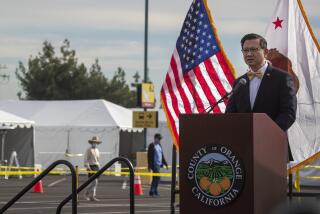Charity Officials Amplify on Spending Reports
- Share via
The story “United Way Scandal Puts Charities Under Scrutiny” (March 30) was a revealing assessment of the current status of guidelines and practices for nonprofit organizations.
As the article said, the United Way of America in Alexandria, Va., has inspired much of the recent charity scrutiny following allegations of misconduct by its former president, William Aramony. As the situation continues to unfold, it is crucial to understand that the United Way of Orange County is only loosely affiliated with the United Way of America and is governed by local volunteers who establish policy and oversee our local organization’s work.
Despite the short-term damage this national controversy may have on charities and our local United Way, we believe that a review of charity practices is healthy and, ultimately, will benefit the level of trust that exists between nonprofits and the public that supports them.
To further this end, the United Way of Orange County is active in efforts to encourage high standards and measures of performance as a participant in the Charities for Truth in Giving coalition here in the county. In addition, the United Way of Orange County supports the uniform accounting procedures referenced in the story and believes that these and other guidelines will enhance donor confidence in reputable charities.
Ironically, the complexities of financial reporting practices were evident in The Times story, as an assessment of local charities’ revenues and expenditures indicated. In an effort to simplify this review of local charities, the story used audits from the 1990 fiscal year for a variety of agencies and, to coin an old adage, “mixed apples and oranges” in its portrayal of the percentage devoted to charities or services.
The story suggested that United Way of Orange County devoted 74% of its total revenues to charities which, in turn, implies that operating costs may be as high as 26%. These percentages do not offer the proper context of costs nor the amount of dollars that are directly and indirectly serving the community.
For example, more than $420,000 of the United Way’s total revenues cited by The Times are actually “restricted” monies that pass through the United Way as a fiscal agent for area health and human service task forces or special projects. These funds are provided by charitable foundations to groups with the understanding that the United Way will administer the grants. An additional $150,000 of the revenue figure is in the form of “capital campaign” contributions, which are earmarked by donors exclusively for building and equipment purchases.
A total of $661,000, although not allocated to outside charities, is devoted to community services through the United Way Information and Referral Network, Hispanic Development Council, and the Funds Distribution and Agency Management Assistance Program. An additional amount of $600,000 was directed to a board of directors-approved contingency fund which exists to provide fiscal security in emergency circumstances, including a fund-raising shortfall that could adversely affect United Way-supported agencies.
The United Way of Orange County’s operating costs for 1990 were 18.7%, which positions it considerably lower than the accepted operating cost level of up to 40%, which is suggested by charity watchdog groups such as the Better Business Bureau and the National Charities Information Bureau.
Examples such as this one in measuring charity effectiveness are precisely the reason why the United Way of Orange County advocates uniform financial and reporting standards among charities. It is not only sound business, but more importantly, it assures the donating public that their generosity is being monitored with the consistency and scrutiny that they deserve.
MERRITT L. JOHNSON, President, United Way of Orange County


